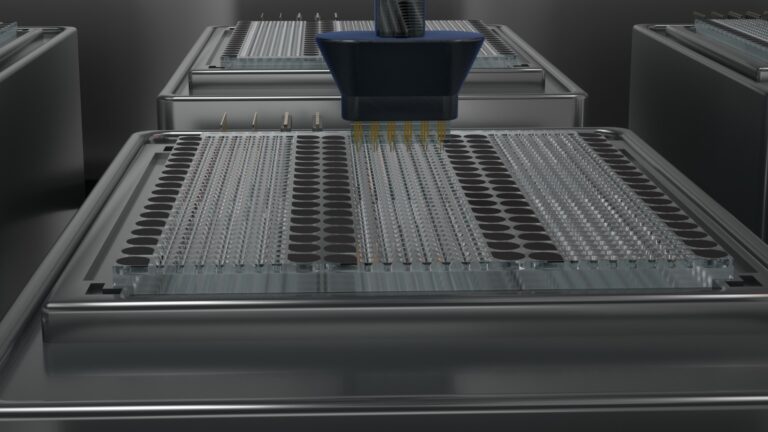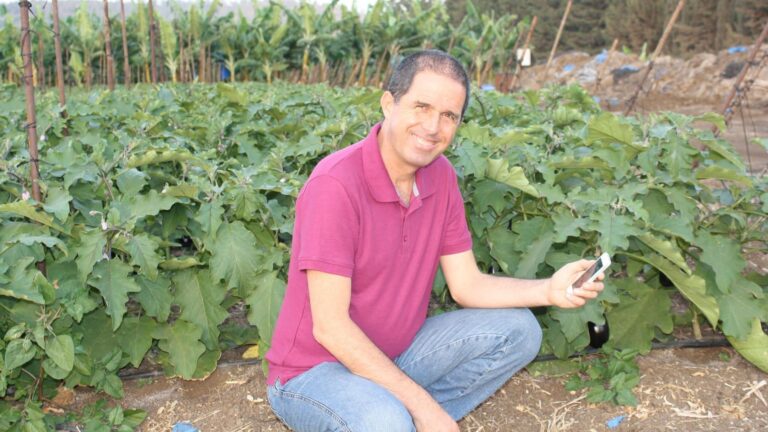The historical Rosetta stone was found by French soldiers near the town of Rosetta in northern Egypt, in 1799. It was a basalt tablet inscribed in 196 BCE with a decree of Ptolemy V of Egypt in two languages (Egyptian and Greek), using three scripts (hieroglyphic, demotic, and Greek). French scholar Jean-Francois Champollion used it to derive a key for translating Egyptian hieroglyphics.
Since that time, Rosetta has been used as a term for the ability to crack previously indecipherable codes.
The name truly suits the Israeli biotech startup Rosetta Genomics, which has developed a new discipline: discovering microRNA, which until recently, was considered an unimportant part of DNA. Just like the historic hieroglyphics from which the company drew its name, everyone saw it, but for a long time, no one could decipher it.
Rosetta Genomics kicked off Israel’s 57th Independence Day celebrations a day early with a reception and conference called ‘Leading the MicroRNA Revolution’ last week. Held at the Weizmann Institute of Science in Rehovot, the conference brought together scientists and investors interested in learning about the developments and discoveries of the company which until recently, had been kept confidential.
The young, Rehovot-based company has good reason to celebrate. Rosetta has now discovered and identified more micro RNAs (gene regulators) than any other research center in the world. The company has identified specific microRNAs associated with prostate cancer and lung cancer (currently engaged in pre-clinical animal studies), Epstein Bar Virus, HIV, and Herpes Simplex Virus.
“From the start, our goal was to achieve a scientific breakthrough that would lead to the development of products for diagnosis and treatment of disease in humans,” said Dr. Isaac Bentwich, founder and CEO of Rosetta.
Most genomic research has been concerned with proteins, and the genes that encode proteins and turn them into cells of a certain type. The DNA region that encodes these proteins, however, constitutes only 2% of DNA. Up until two years ago, the other 98% of the genome was considered to serve no function. It was even known as ‘junk DNA’.
“For 40 years, research has focused on protein encoding DNA, because it was assumed that all the rest was just there, serving no purpose,” said Bentwich. “We focused our attention on a field that was rather neglected. The basic idea was to look for a new group of genes that did not encode proteins. The amazing thing is that we found them.”
Bentwich calls what followed “a scientific earthquake.”
“All of a sudden, it turned out that what were thought to be useless genes were of decisive importance. They are far from being junk DNA. A series of discoveries proved that extensive regions of junk DNA (that do not encode proteins) are produced by the cell, and preserved throughout its evolution. This is evidence that they have a function.”
Rosetta Genomics has found a way of using advanced computer technology to reveal the encoding genes through the microRNA genes. This is now one of the hottest topics in biology. Published research in the field shows that these genes are linked to, and affect, a variety of diseases, such as diabetes, cancer, anemia, and neurological disorders.
Rosetta Genomics’ great innovation is that it has managed to find a large number of genes that couldn’t be identified through known technological means, Bentwich says.
The breakthrough has attracted a slew of high profile Israeli investors: Pharmaceutical gian Teva, Leon Recanati and his investment company Glenrock Israel; VCON Telecommunications CEO and former Scitex CEO Yair Shamir; Agis Industries president and chairman Moshe Arkin; Israeli high tech pioneer Uzia Galil; and Prof. Michael Sela, Israel Prize laureate and former president of the Weizmann Institute of Science.
Bentwich first got his idea to focus on the role of microRNAs while studying meditation in the Himalayas in 1999.
“I’ve spent long periods in India,” he says, “I studied Tibetan Buddhism and various meditation techniques related to tantra. The inspiration came at the end of four months of studying meditation in the Himalayas, not far from the city of Dharamsala. The idea was linked to a puzzle that has preoccupied me since I was 15 years old. I’m referring to the basic puzzle of biology how every cell in the body has the same DNA, yet different cells are differentiated into various types: muscle cells, nerve cells, brain cells, etc. Science still doesn’t know the full answer to the central question of what causes cells to function differently,” he told Globes.
He established Rosetta in 2000, with the support of his father, Prof. Zvi Bentwich, an immunologist, and one of the world’s leading AIDS researchers. Isaac Bentwich returned to Israel, told his father about his idea, and started to promote it. His father joined the effort, and is currently both chief scientist of the company and chairman of its scientific advisory board.
Speaking at last week’s conference, the elder Bentwich proudly gave a brief summary of the scientific discoveries that have marked Rosetta’s journey.
“We have discovered 180 microRNAs, and hundreds are in the pipeline. Rosetta is in a position to own 80% of all the known microRNAs,” he said.
“The company began looking for microRNAs several years before other scientists believed they existed. It gave us an edge,” the younger Bentwich added.
According to him, Rosetta’s other edge in the field is its computer system.
“Up until now, the conventional approach was biological, based on the removal of RNA from the cell. Our approach is innovative in that it identifies genes by computer, and only afterwards verifies their existence in a biological laboratory. The success is primarily thanks to Rosetta’s teamwork. We are blessed with an amazing group of talented, creative, dedicated young people, computer people and biologists, who have succeeded in tackling the huge technical challenges we faced.”
“The computer finds these genes by analyzing the genomic formats. That’s what’s ‘exotic’ about our story. Only after finding them in a dry run do we look for biological verification to confirm the discovery.”
“Rosetta Genomics has combined scientific disciplines in an original way. The combination of biotechnology and bioinformatics with genetics is innovative and revolutionary. So is the idea of trying use a computer to predict genes, and proving the prediction in a laboratory only afterwards. In the second stage, we’re trying to take segments of genes, and link them with diseases. After verification, we can try to devise treatment for the diseases from those segments.”
According to Bentwich, the first stage that of gene prediction and verification has been achieved. There are already patents and several dozen genes have already been proven. The company is now linking genes to diseases.
“These treatments will be based on microRNA, which scientists until recently thought were junk genes. It is now clear to everyone that they are goldmines. Rosetta Genomics has reached the applications stage. In this stage, we’ll conduct animal trials on genetic splices. We are collaborating with medical companies, and Rosetta Genomics’ know-how will be the basis for the medical treatments of the next two decades.”
Zvi Bentwich jut returned from a conference in Boston at the beginning of May, and he reported on a rising interest in the field, noting an exponential explosion of articles published on microRNAs since 2001. In the year 2002, Time magazine wrote that microRNAs was one of the ten most important discoveries of the year.
“One scientist [at the conference in Boston] who had said that there were probably only about 255 microRNAs, now admitted that he was wrong. He put the number on the blackboard, and crossed it out. Now the scientific community has accepted the fact that there are a large number of microRNAs,” he said.
After keeping their operation secret for a number of years, Rosetta is beginning to make noise with its discoveries. An article on Rosetta?s chip platform has been accepted by the prestigious journal Genome Research, and will be published soon
Showing the relationship between the DNA, RNA, and protein on a slide, the senior Bentwich commented: “MicroRNAs are a small part of the RNA. They connect with the messenger (mRNA) to create protein. All microRNAs come into the world to regulate the process of creating proteins.”
“Picking out microRNAs was like finding a needle in a haystack. Bioinformatics was the basis of Rosetta when it was first established. The company also developed a proprietary system to detect and identify microRNA signals (they light up) on a chip, and also a biological system to locate microRNAs in a sequence.”
“What can we do with it? When we see that there are 18 times more microRNAs in a diseased tissue as compared to a normal tissue, which can happen in cancer, we have the possibility of intervening.”
A recent press release was distributed to participants at the conference last week: Rosetta Genomics scientists found that if they silence one microRNA in a cluster in an EBV infected cell, there is a dramatic reduction in the infection of human cells by EBV.
Prof Bentwich stated: “This is the first proof that viral encoded microRNAs are important for viral replication and has immediate relevance to development of antiviral drugs.”
Keynote speaker at the conference was Technion Professor Aaron Ciechanover, co-winner of the Nobel Prize in Chemistry in 2004, and Chairman of the Scientific Advisory Board of Rosetta, a position he took before he won the Nobel Prize.
“When I first heard about the company, I was a skeptic; then, I became a believer; and now I am very enthusiastic,” said Ciechanover. “When it started off as a small software company in Jerusalem, I said you won’t get any place without a wet lab. Now the company is well organized – with a strong bioinformatics branch; and labs that validate their identifications.”
Among the guests at the conference was Uzia Galil, a pioneer in industry in Israel. Galil, most of whose investments are in consumer electronics told ISRAEL21c that Rosetta is the only biotechnology company in which he is investing. “It is the most promising.”
Dr. Joshua Rosensweig, Chairman of the First International Bank of Israel (and now a member of the Rosetta Genomics Board), commented that when the company first came to him for financial advice, he gave advice and then asked: “How can I invest?”
“We have had a burst of business activity,” said Sharon Kaspi, VP Business Development. “The company is currently in the midst of negotiations for several important contracts for commercialization and collaboration.”
Weizmann Institute of Science Department of Molecular Genetics director Prof. Doron Lancet, one of the heads of Israel’s genome project, had the final word.
“Rosetta Genomics is working in the hot new field of genome research. It is utilizing scientific discoveries that have changed the previous paradigm. That’s a revolution.”
(Based on a report in Globes)















